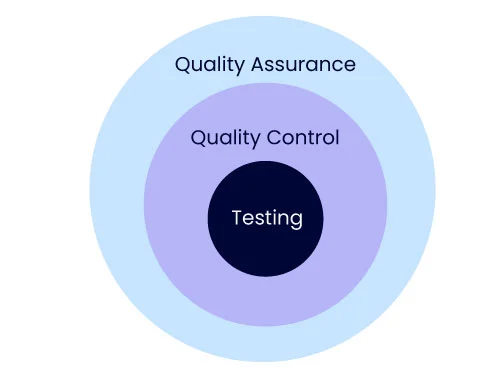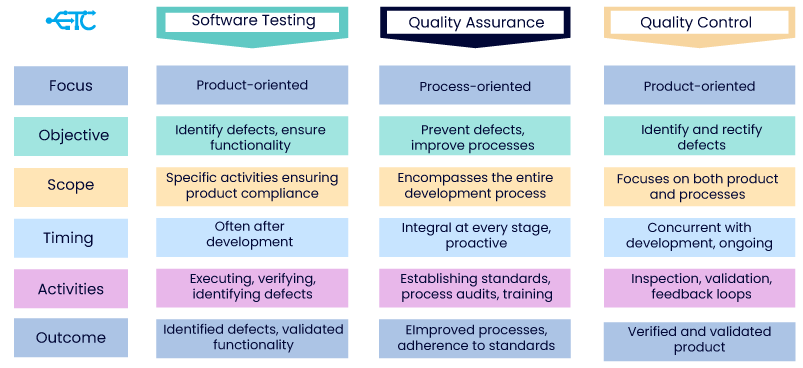What Sets Apart Testing, Quality Assurance and Quality Control?
In the dynamic landscape of tech development, the pursuit of excellence hinges on the nuanced understanding of three integral processes: testing, quality control (QC), and quality assurance (QA). Often used interchangeably, these terms encapsulate distinct facets of the development lifecycle.
This article aims to elucidate the unique characteristics that differentiate testing, quality control, and quality assurance, offering insights into their specialized roles in achieving and sustaining optimal product quality.

What is software testing ?
Software testing, a meticulous process of evaluating a software application or system, aims to identify any disparities between expected and actual outcomes. It involves executing a program or application with the intent of uncovering software bugs or defects. The primary goal is to ensure the software functions correctly, adheres to specified requirements, and delivers reliable, high-quality performance to end users.
Key aspects of software testing encompass defect identification, functionality verification, validation of requirements, error detection, performance evaluation, and the enhancement of overall quality by addressing defects early in the development process.
What is quality assurance?
Quality assurance (QA) stands as a comprehensive and systematic process integrated throughout the software development lifecycle. It focuses on continuous process improvement to enhance efficiency, reduce errors, and optimize workflows. QA activities include establishing and enforcing coding standards, providing training sessions for skill development, and creating documentation for clarity and consistency. QA ensures adherence to specified quality standards, prevents defects, and maintains consistent high quality throughout development.
What is quality control ?
Quality control (QC) encompasses a set of systematic activities within the software development lifecycle, ensuring the quality and reliability of the final product. Unlike QA, which emphasizes process improvement, QC is more product-centric. It involves testing processes, inspection and review, validation of the final product, defect correction, and the establishment of a continuous feedback loop for process improvement. QC ensures the product meets specified requirements and adheres to established quality standards.
Comparison between Testing ,QA and QC: A Comprehensive Overview
Testing, Quality Assurance (QA) and Quality Control (QC) are integral components of the software development process, each with distinct roles and objectives. Let’s explore the key differences between QA, QC, and Testing:

What are 7 software testing principles?
While the number of software testing principles can vary, here are seven fundamental principles that guide effective software testing:
• Early Testing:
Begin testing activities as early as possible in the software development lifecycle. Early testing helps detect and address defects at their source, reducing the cost of fixing issues later in the process.
• Exhaustive Testing is Impossible:
It is impractical to test every possible input and scenario. Instead, focus testing efforts on critical areas, high-risk functionalities, and scenarios that have a higher likelihood of revealing defects.
• Pesticide Paradox:
Repeating the same set of tests will not uncover new defects. Regularly update and diversify test cases to ensure that testing remains effective and uncovers evolving issues.
• Testing is Context-Dependent:
The testing approach and techniques should be adapted to the specific context of the project, considering factors such as project size, complexity, and criticality.
• Defect Clustering:
A small number of modules or functionalities often contain the majority of defects. Prioritize testing efforts on areas that historically have a higher density of defects.
• Absence-of-Errors Fallacy:
The absence of detected errors in testing does not guarantee a defect-free product. It indicates that no errors were found, but it does not prove their absence.
• Testing Shows Presence of Defects:
Testing can demonstrate the presence of defects but cannot prove their absence. Testing provides information about the software’s quality, helping stakeholders make informed decisions.
The role of testing in software development life cycle (SDLC)
• Requirements Analysis:
In this initial phase, testing involves validating the clarity, completeness, and consistency of the requirements. Early identification of ambiguities or inconsistencies helps prevent downstream issues.
• System Design:
Testing in the system design phase focuses on verifying that the design meets the specified requirements. It involves reviews, inspections, and validation of design documents to ensure they align with project goals.
• Implementation (Coding) Phase:
Unit testing is performed to validate individual units of code. Developers test their code to ensure it meets the design specifications and functions correctly in isolation.
• Integration Phase:
Integration testing verifies the interaction between integrated components or modules. It ensures that combined units work seamlessly and identifies issues related to data flow, interfaces, and system interactions.
• System Testing:
This phase involves testing the entire system as a whole. It ensures that the integrated components function as intended and meet all specified requirements. System testing includes functional, performance, security, and usability testing.
• User Acceptance Testing (UAT):
UAT is performed by end-users to validate whether the software meets their business needs and requirements. It is the final testing phase before the software is released to production.
• Deployment Phase:
Testing during deployment involves verifying that the software is correctly installed and configured in the production environment. It ensures a smooth transition from development to live production.
• Maintenance and Support:
Even after deployment, testing continues during maintenance and support phases. It involves regression testing to ensure that new changes or updates do not introduce defects and that the system remains stable and reliable.
Conclusion
In the intricate web of software development, understanding the distinctive roles of testing, quality assurance, and quality control is paramount. Each process contributes uniquely to the overarching goal of delivering high-quality software products.
As we navigate the dynamic landscape of tech, recognizing the nuances of these integral processes becomes a compass guiding us towards excellence. Whether it’s the meticulous scrutiny of software functionality, the continuous improvement of development processes, or the product-centric focus on quality, each facet plays a crucial part in achieving and sustaining optimal product quality.
In essence, the synergy of testing, quality assurance, and quality control forms the bedrock of software development excellence. By comprehending their unique characteristics, we empower ourselves to steer projects towards success, ensuring not just functionality but a holistic commitment to quality across the development lifecycle.
